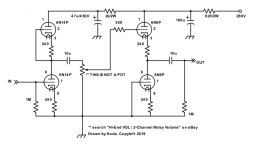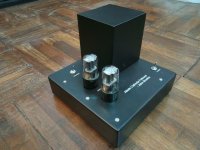Ohhh... Makes sense....
That's great to know!
Actually answers a few questions for me...
Thanks!
BTW.... 30k seemed to work out best for my project... (Aikido ACF 9pin in linestage)..
Since the variables can only be calculated up to a point... (long interconnects, varying amp impedances etc).. 30 would do the least harm, as close as I can calculate it..
That's great to know!
Actually answers a few questions for me...
Thanks!
BTW.... 30k seemed to work out best for my project... (Aikido ACF 9pin in linestage)..
Since the variables can only be calculated up to a point... (long interconnects, varying amp impedances etc).. 30 would do the least harm, as close as I can calculate it..
Last edited:
Well... that was sorta the whole point of choosing/using the ACF buffer...As long as the source can drive it, it can be as low as you want
Helps various sources drive various things...
That's what I meant...My solid state power amp is 10k Zin... My tube amps are around 90k... If you go too high you get HF rolloff due to CMiller though... Then you need either pentode or cascode input...
Given a variety of amps (that I might eventually use) with that or even greater span of input impedance... 30k is the best compromise so as to (at least try to) avoid the Miller thing..
Bear in mind also, that you go to low, you get LF rolloff...
Ohhh... Makes sense....
That's great to know!
Actually answers a few questions for me...
Thanks!
BTW.... 30k seemed to work out best for my project... (Aikido ACF 9pin in linestage)..
Since the variables can only be calculated up to a point... (long interconnects, varying amp impedances etc).. 30 would do the least harm, as close as I can calculate it..
30k is a pot spec I haven't heard off, the usual suspects being Alps@20, 50, 100K etc.
What make is that ?
Found it! LMAO
RJS30KE Ohmite | Potentiometers, Variable Resistors | DigiKey
The higher the capacitance, the lower the grid leak for a given frequency...
I find "small signal" stuff is fine with 1 meg... For audio anyway... Even in a "I could feel it even if I don't hear it" amp... Most of the tubes we use were spec'd for VHF, right? Audio is a cakewalk...
I usually use 51k - 100k on power tubes though...
RJS30KE Ohmite | Potentiometers, Variable Resistors | DigiKey
The higher the capacitance, the lower the grid leak for a given frequency...
I find "small signal" stuff is fine with 1 meg... For audio anyway... Even in a "I could feel it even if I don't hear it" amp... Most of the tubes we use were spec'd for VHF, right? Audio is a cakewalk...
I usually use 51k - 100k on power tubes though...
50K looks like the perfect middle ground. I'm using the ACF with a 4S preamp, wich already has a 250K pot at the input.
This one is a linear pot. Is that ok ? Thought 'log' was the way to go.
This one is a linear pot. Is that ok ? Thought 'log' was the way to go.
No, it must be LOG. I was being facetious...
50k should be fine. I use 100k as the middle ground. I used to use 1 MEG!

50K looks like the perfect middle ground.
Making the BEST choice nescessitates knowing to a certainty the impedance of the source and load... Especially the load.. Knowing total cable capacitance, and input capacitance of the load, is crucial, but it's rare that one does... In most cases, you'll wind up making a "best guess" at it, since knowing cable capacitance is something most don't.... and knowing the input capacitance of the load component usually requires manufacturer giving that knowledge... and they usually don't.
The consequence of getting this wrong.... is basically creating a filter... a Bandpass RC filter.. It will prematurely roll off either the highs or the lows... depending on whether you've chosen a higher or lower pot value....
Here is a very comprehensive thread on the subject: How to determine what value Pot (attenuator)???

Using a log pot between the input switch and the active circuitry as a volume control forces certain compromises. You know you're in trouble when you cannot fully control something "crucial" to performance, such as the cable capacitance when cables can easily be replaced. A better choice is to design the conditionality and compromises out of the volume control, as Baxandall did decades ago. Yet, the log pot tradition holds.
Last edited:
My solution is to just bypass the pot altogether and use an AVC! 

Tribute - The final word in audiotransformers
Tribute - The final word in audiotransformers
My solution is this:
I use one of these:Hi-End VOL / 2-Channel Relay Volume Control Board /Stereo volume board | eBay
I've tested it, and it's lowest Rin was about 1k or so. '
Here's the circuit:
I should say I've replaced the pot they give you with one of these... 1Pcs WXD3-13-2W 22K 220R Multiturn Trimming Potentiometer Variable Resistor | eBay
I use one of these:Hi-End VOL / 2-Channel Relay Volume Control Board /Stereo volume board | eBay
I've tested it, and it's lowest Rin was about 1k or so. '
Here's the circuit:
I should say I've replaced the pot they give you with one of these... 1Pcs WXD3-13-2W 22K 220R Multiturn Trimming Potentiometer Variable Resistor | eBay
Attachments
Last edited:
It seems it uses a pot plus ADC combination to control the relays. Do you experience the issue sometimes mentioned in connection with that arrangement, where the LSB of the ADC in certain pot positions is not stable and flickers between 0 and 1, so the respective relay keeps clicking even though the pot is not being turned?My solution is this:
I use one of these:Hi-End VOL / 2-Channel Relay Volume Control Board /Stereo volume board | eBay
Hi, the ACF-2 is done. Here's a pic of the cabinet that is w.i.p.
Is it fine to print John's name on the top plate ? Any problems with copyright ?
Please help answer.
- Home
- Amplifiers
- Tubes / Valves
- Glassware Aikido All-in-One (Octal) | ACF-2 Buffer


